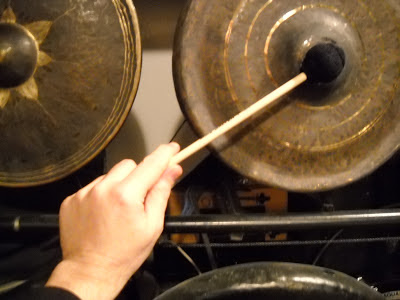Defying Gravity - Part 2
Grip. It's all about the grip.
Having played percussion most of my life, I've played all the different instruments and all musical styles. Since delving heavily into the Gongs, I've noticed I've had to adjust my grip and playing techniques. As I detailed in Part 1, I've moved from a horizontal playing surface to a mostly vertical one. This brings about some fundamental changes in the physics & motion of the stick/mallet movement.
First, let's look at my standard mallet grip:
My grip changes somewhat depending on the diameter of the mallet shaft I'm using. With a larger diameter, sort of 5A drumstick or larger (like the Balter Wind Gong Mallet in the photos), I almost always keep my thumb past my forefinger. This gives me some leverage and helps to keep the mallet from moving too far back. The thumb and forefinger are still the pivot point for the mallet (it's a thumbs up grip). The remaining 3 fingers are the ones that activate the mallet, pulling it towards the palm (causing the mallet head to move towards the Gong), then releasing it, allowing the mallet head to fall back. This all works because the head of the mallet is heavier than the rest of the stick (using gravity as an advantage). Again, think of a pendulum with a weight attached to the end and how easily it swings back & forth.
Fingers released, allowing the mallet head to swing back.
Fingers pulling mallet towards the palm/mallet head towards the Gong.
Fingers holding mallet in full stroke position.
Again, getting a nice single stroke roll going is a simple and effortless process, as the mallet isn't fighting against gravity, but activley working with it. At no time am I actually lifting the mallet, like in a normal horizontal playing position. I've been able to play like this for more than an hour straight with little fatigue or discomfort.
With the smaller tuned Gongs, I'm holding the mallet in a rather firm grip (palm down/thumbs to the side). I usually use a vibe/marimba mallet, so the smaller shaft needs to be gripped firmly for control (the thumb & forefinger are usually even), and to be secure. I'm not looking for the mallet to pivot as much and make my stroke motion more from the wrist.
Mallet grip with a smaller shaft. Thumb & forefinger more even,
with the forefinger sometimes past the thumb.
with the forefinger sometimes past the thumb.
The actual grip is with the last 3 fingers, holding the mallet tight.
Next time, large Gong mallets & multi-mallet grips.
~ MB










Comments
Post a Comment